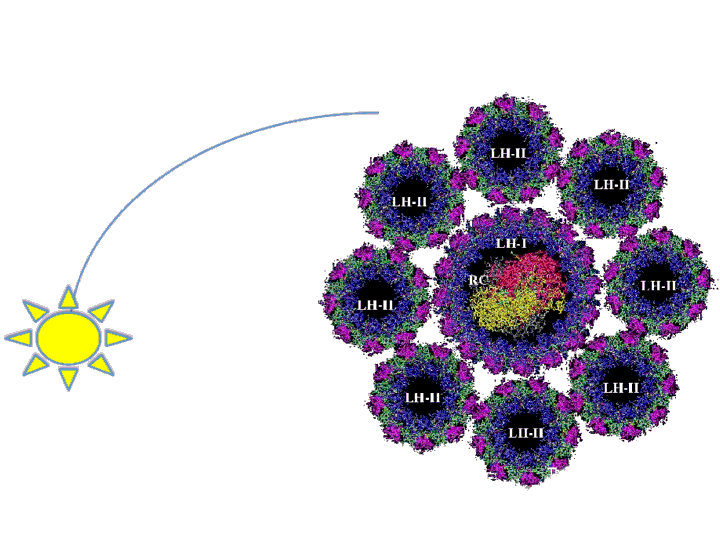|
|
| Line 4: |
Line 4: |
| | | | |
| | <div style="text-align: left;"> <font size="4" style="color:black"> | | <div style="text-align: left;"> <font size="4" style="color:black"> |
| - | == '''Abstract''' == | + | == '''摘要''' == |
| | <font size="2"> | | <font size="2"> |
| | [[image:LH2Changes.gif|300px|right]] | | [[image:LH2Changes.gif|300px|right]] |
| - | Our project goal is to maximize the photosynthetic productivity for a culture of Rhodobacter sphaeroides under both high and low light intensities in a bioreactor by synthetically regulating the size of the light-harvesting antenna. We chose to undertake such a project in R. sphaeroides due to its well-characterized photosynthetic and genetic system.
| + | 我们项目的目标是最大限度地光合生产率文化的红假单胞菌下的高,低光照强度的生物反应器的综合调控的规模,捕光天线。我们选择进行这样一个项目在河米由于其良好的光合特征和遗传系统。该天线系统功能扩展频谱的光进行光合作用可吸收不同波长比反应中心。从本质上讲,它是像周围的菜的主要接收任何天线。海洋细菌,如河米,形成非常大的天线复合吸收自然光环境下也有很大的竞争光子。其结果是,饱和光合机制在相当低的光照强度的一种合成非竞争的环境,如生物反应器。这将导致高达95 %的附带光子散失的热量或荧光的细菌在外部的生物反应器,通过这个过程被称为非光化学猝灭(热耗散) ( Mussgnug等。 , 2007年) 。从本质上讲,这些光子正在降低热耗散浪费轻渗透到生物反应器和挨饿细胞内部的光子。一种方法已被证明是提高光合效率,减少捕光天线尺寸( Polle等。 , 2002年, Mussgnug等。 , 2007年) 。虽然,目前的办法,为此依靠基因敲除,因此很难精确地控制视野下的代谢工程和合成生物学。我们的意图是建立一个更有活力的制度,以不同的天线大小,依赖于偶然的光照强度,并且可以非常容易地优化利用合成生物学的原则。这个系统应该导致细菌在外部的生物反应器表达少捕光天线蛋白比细胞内部,减少热耗散,同时保持高吸光度附带光子。我们将集中在改变的数量,捕光复合2 ( LH2 )通过调节pucB /阿基因代码,这两个亚单位的复杂。 LH2最大限度地吸收光子的波长为842 nm和渠道其能源LH1和反应中心。比例LH2复合物,以LH1自然范围从3.0至6.7在不同光线条件( Scheuring等。 , 2005年) 。我们建议,如果这一比率到LH1是LH2改为从0-7或以上的回应附带光照强度,那么,光合效率和生产力,文化的河细菌可能是最大的。 |
| - | | + | |
| - | The antenna system functions to expand the spectrum of light available for photosynthesis by absorbing different wavelengths than that of the reaction center. Essentially, it is like the dish around the main receiver of any antenna. Marine bacteria, such as R. sphaeroides, evolved very large antenna complexes to absorb light in a natural environment where there is great competition for photons. As a result, the photosynthetic machinery is saturated at a rather low light intensity in a synthetic non-competitive environment, such as a bioreactor. This causes up to 95% of incidental photons to be dissipated as heat or fluorescence by the bacteria at the exterior of a bioreactor through a process called Non-Photochemical Quenching (NPQ) (Mussgnug et al., 2007). In essence, these photons are being wasted as NPQ reduces light penetration into a bioreactor and starves cells on the interior for photons. One method that has been shown to improve photosynthetic efficiency is the reduction of light-harvesting antenna sizes (Polle et al., 2002, Mussgnug et al., 2007). Though, current approaches to this end rely on genetic knockouts and as such are difficult to precisely control from the perspective of metabolic engineering and synthetic biology. Our intention is to create a more dynamic system to vary antenna size that is dependent on incidental light intensity and that can be readily optimized using synthetic biology principles. This system should result in the bacteria at the exterior of the bioreactor expressing fewer light harvesting antenna proteins than the cells at the interior, reducing NPQ while maintaining a high absorbance of incidental photons.
| + | |
| - | | + | |
| - | We will focus on altering the quantity of the Light Harvesting Complex 2 (LH2) by regulating the pucB/A genes that code for the two subunits of the complex. LH2 absorbs photons maximally at the wavelength of 842 nm and funnels its energy to LH1 and the reaction center. The ratio of LH2 complexes to LH1 naturally ranges from 3.0 to 6.7 under varying light conditions (Scheuring et al., 2005). We propose that if this ratio of LH2 to LH1 is altered to range from 0-7 or more in response to incidental light intensity, then the photosynthetic efficiency and productivity for a culture of R. sphaeroides may be maximized.
| + | |
| | <br>[[Team:Wash_U/Project#Abstract|Back To Top]] | | <br>[[Team:Wash_U/Project#Abstract|Back To Top]] |
| | | | |
| | <font size="4"> | | <font size="4"> |
| - | == '''Analysis''' == | + | == '''分析''' == |
| | <font size="2"> | | <font size="2"> |
| | full report | | full report |
| | <br>[[Team:Wash_U/Project#Abstract|Back To Top]] | | <br>[[Team:Wash_U/Project#Abstract|Back To Top]] |
| | <font size="4"> | | <font size="4"> |
| - | == '''Results''' == | + | == '''结果''' == |
| | <font size="2"> | | <font size="2"> |
| | results | | results |
| | <br>[[Team:Wash_U/Project#Abstract|Back To Top]] | | <br>[[Team:Wash_U/Project#Abstract|Back To Top]] |
| | <font size="4"> | | <font size="4"> |
| - | | + | == '''结论''' == |
| - | == '''Conclusion''' == | + | |
| | <font size="2"> | | <font size="2"> |
| | conclusion | | conclusion |
| | <br>[[Team:Wash_U/Project#Abstract|Back To Top]] | | <br>[[Team:Wash_U/Project#Abstract|Back To Top]] |
| | <font size="4"> | | <font size="4"> |
| - | == '''References''' == | + | == '''参考资料''' == |
| | <font size="2"> | | <font size="2"> |
| | # "2007-2008 Catalog & Technical Reference." <u>New England BioLabs Inc.</u> (2007). | | # "2007-2008 Catalog & Technical Reference." <u>New England BioLabs Inc.</u> (2007). |

 "
"

